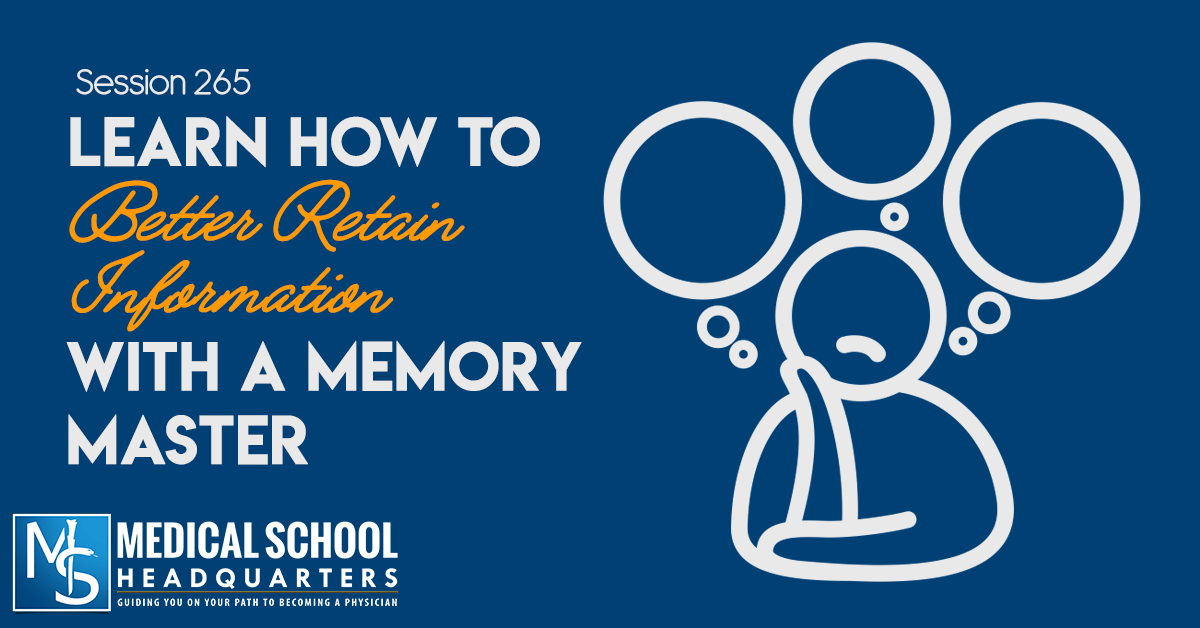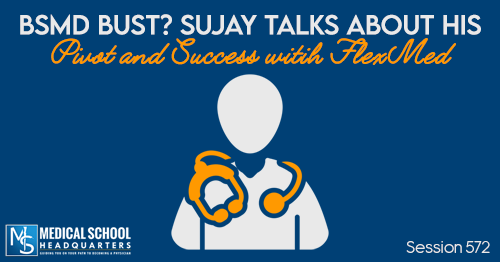Apple Podcasts | Google Podcasts

Session 265
Luis Angel was a Memory Master Champion on FOX’s Superhuman Show. Luis also wrote a book called Better Memory Now. Listen in as they talk about how you can learn to retain more information to improve your grades!
Several students are having study technique issues. They can’t study well and need better study habits. So Ryan went out and found Luis. He has competed in memory competitions and has written a book about it.
Today, Ryan and Luis discuss how you as a premed can better prepare yourself to learn and better learn what you’re already studying.
[01:15] Becoming a Memory Athlete
If you thought Luis was born coming out of the womb memorizing a deck of cards, you’re wrong. He actually struggled a lot in high school through college. Even up to the point that it drove him to discover this. That’s what drove him to discover this because he was failing in his English and Science classes.
Then his English teacher told gave him a D minus so can move one. It was that grade in high school that got him to pursue to be able to graduate high school.
When he got to college, he was looking forward to having a fresh start. But having the same blueprint he had in the past and expecting a different result, he obviously didn’t get the results he wanted. He got on probation and got kicked out of the semester.
[Tweet “”When you go into a new situation with the same blueprint that you’ve had in the past, expecting a different result, you normally don’t get that.” https://medicalschoolhq.net/pmy-265-learn-how-to-better-retain-information-with-a-memory-master/”]
Not doing great at school he was told he had ADD (Attention Deficit Disorder), His psychologist gave him the meds. Luis thinks that while some people need them, he personally didn’t prefer that route. He wanted the natural fix. So he went the memory training route of improving his memory. Now, he competes all over the world. He was on FOX’s Superhuman Show.
[03:30] The Biggest Thing He Has Memorized
For Luis, the biggest feat for him was on that show. He had done for hours in huge competitions. But for the Superhuman Show, he had to memorize over a hundred people’s names. This includes their first name, last name initial, their home towns. He obviously had to memorize the faces and something special about them. He was under pressure with all the lights and the celebrities out there and family members. So for him it was the biggest thing with over 500 pieces of information he had to memorize that day. It wasn’t like he wasn’t given months or weeks to prepare or get that information in his head. And he got everything correct!
In actual memorizing memory competitions, he has memorized thousands of numbers in a matter of an hour, doing over two hundreds in five minutes.
[05:10] Moving Short Term Memory to Long Term Memory
Luis explains there are three steps to memorize anything quickly. This depends on the type of material you’re trying to memorize and what it’s going to take for you to commit that to memory.
When you’re memorizing elements or anatomical structure, this technique is easier to apply and commit them to long term memory. First, you need a location. Be able to store the information on a specific place. They call these memory maps or mental journeys in their minds. Second, visualize.Turn the information you want to retain into an image or story in the text to the location. Third step is review. If you don’t review the information, it doesn’t matter if you’re the best memorizer in the world or you’re just getting started. If you don’t review, you’re going to forget.
[Tweet “”Apply the memory techniques and then do the review aspect of that to retain that information.” https://medicalschoolhq.net/pmy-265-learn-how-to-better-retain-information-with-a-memory-master/”]
[07:38] Before Anything Else: The Mindset Change
The first thing to do is to change your mindset. Tony Robbins was a great inspiration for Luis. Before he even got to the memory side of the world, he first got into personal development. He went out there and sought individuals who are performing at an optimal level. He learned how they got to that point.
One of the things Tony talks about is having these limiting beliefs that we place on ourselves. Or it can be our environment, the people we grew up with or we watch online that are placing these limiting beliefs on ourselves. So we have to break through those. What he usually does in his events is walking through flaming hot coals. It challenges you to overcome that and come to their side.
[Tweet “”For me, it was all about having these limiting beliefs and destroying them. That’s what really got me to focus.” https://medicalschoolhq.net/pmy-265-learn-how-to-better-retain-information-with-a-memory-master/”]
[09:00] The Sledge Hammer of Positive Intent
Luis further explains he can teach people to memorize very quickly or how to compete in memory competitions. But at the end of the day, if you’re not really motivated and you don’t believe in yourself that you can do it, you’re going to do you no service.
If you have that wall of limitations that you place on yourself – that you can’t do it, you’re slow and you’re stupid, you can’t read, etc., build a huge sledge hammer to destroy that wall and bring it down. That sledge hammer was made with positive intent. So you have to tell yourself that you can do this. You’re smart. You can learn quickly. You can read this material and retain it for a longer period of time. When Luis goes to schools, working with students, he has them going through these positive incantations that they can, they will, and they must.
[Tweet “”Before even getting started with anything else, even the memory techniques, is building that foundation of positivity that they can and they will achieve their goals.” https://medicalschoolhq.net/pmy-265-learn-how-to-better-retain-information-with-a-memory-master/”]
Resources Luis recommends to help you include reading the book, Awaken the Giant Within by Tony Robbins. Luis wrote a book called Better Memory Now. He does some exercises and some meditation. There YouTube videos you can watch Les Brown is a huge inspiration for him as well as Jim Rohn.
Even if you can’t surround yourself with individuals that always stay positive and always motivating, you can always read these books or watch the videos. Or you can follow anyone in your field that you can connect with. If they’re uplifting and motivating, listen to them or read their books. Jim Rohn has the famous quote: You’re the average of the five people who surround you. So it’s really important to surround yourself with positive people to help support you.
[11:55] More Strategies to Become a Memory Athlete
Again, Luis discusses creating this memory map or memory palettes in your mind. You ca write this down first but you’re going to want this in your mind when you’re learning the information. You can just easily store it along this route.
Luis practices this with Ryan. Imagine you’re at the front door to your home. Open the door and what is the first room you walk into into? Look around the room and look at everything in there. Ryan is imagining walking into his child’s playroom.
Then go clockwise and choose five different locations or things in the room (ex. toy chest, lamp, painting, etc). Starting from the left side of the room going clockwise, imagine the first thing you picture. Then to the write, imagine the second thing you see. The third, fourth, and then five. Ryan sees the easel, drawer system for toys, kitchen play set, dollhouse, his daughter’s picture eating cake on her first birthday.
From one through five, just go through those again. Then go backwards. Then what is number 2, number 5, and number one. Just go back and forth. Now, you’ve memorized five things. And Luis explains we’ve got thousands of these in our heads whenever they compete since they have to memorize a boat load of information very quickly.
[15:50] Do You Have to Be a Visual Person to Do Well at This?
Luis has found that this technique embodies all of learning ways (visual, auditory, etc.). Because when you’re visualizing, you’re not only visualizing the space you’re in, but you’re actually imagining you’re there. You’re creating the sounds, too.
You sense everything that’s happening in that space. So he doesn’t really think this is just for those really good at visualizing. This works for almost everyone. In fact, he was worked with a blind person and in their way, they were able to visualize the information.
Moreover, activating the senses is a huge memory booster. Hence, you need to add as many senses as you possibly can with the stories you’re creating. Don’t just visualize it. But imagine what you see, hear, smell, feel, when you’re seeing that information.
[Tweet “”Place yourself in these rooms and visualize yourself actually interacting with these locations because that’s going to cement them deeper into your memory bank.” https://medicalschoolhq.net/pmy-265-learn-how-to-better-retain-information-with-a-memory-master/”]
[18:13] Review in Chunks
Luis explains the reason you have to memorize it forwards, backwards, and by number is because of the review aspect. Whenever you review something, you’re building on the myelin in your brains to cement this into long term memory, in that specific order.
[Tweet “”When you’re creating these locations on your own, do them in blocks of five. Do them forwards, backwards, by number. Then we move on to the next five.” https://medicalschoolhq.net/pmy-265-learn-how-to-better-retain-information-with-a-memory-master/”]
Once you do this a few times, then you group that into blocks of ten. The general tip is to not learn everything all at once or cram everything the night before the exam. Do it i block and in chunks. Then take breaks in between as well. Whenever Luis learns something new, he does it in chunks and blocks. Then before moving on to the next one, he reviews the next chunk.
[19:37] From Memorizing Images to Memorizing Stuff
Luis then gives basic words and images to apply. Luis wants Ryan to picture out right there on the easel is a bone inside of an envelope. On the drawer, picture a toad playing with poker cards. Then add more animation to it to help link them together.
Then on the third location, Ryan is made to picture berries in the kitchen area. Imagine how you associate them together. Ryan imagines opening up the fridge, seeing the berries and squishing them to get the juice dripping down on the side.
For the fourth location, the dollhouse, picture a very dry towel coming apart. Then associate that with the dollhouse. Ryan imagines one of the dolls tearing it apart.
On the picture area (fifth location), picture a dog with an oxygen mask and eating a big dinner plate of turkey. He’s trying to melt it down with nuclear acid.
Then Luis asks Ryan the first thing he memorized. And Ryan’s answer is the dog with the bone in an envelope on the easel. The word here is benevolent. Whenever he’s memorizing a word, he asks himself what the word reminds him of when he’s looking at it.
Bone for “bene” part and envelope for the “volent” part. The he creates the story and pictures dogs around. So his dog is being very kind with the chihuahuas, the dog is giving the bone in the envelope.
So when you’re trying to memorize your material, try to be playful with the information.
[Tweet “”Create these stories in a playful manner because it’s going to make it more entertaining and more fun for you to actually sit down and learn the materials as well.” https://medicalschoolhq.net/pmy-265-learn-how-to-better-retain-information-with-a-memory-master/”]
[24:20] Making it Personal or Using Other People’s Stories?
Luis recommends creating your own stories because you’re more connected with the material. Other students might create some metaphors and analogies you’re not too fond of. So do your best to create your own. But in the same sense, if you want to get ideas from other students a bit, you can do that too. At the end of the day, however those stories have been created, it’s going to be a much better way to learn the materials and have it stick to long term memory than if you just try to do it the usual way of repeating information over and over again.
[Tweet “”Our brain learns best when it can connect in the story form, in the metaphorical form.” https://medicalschoolhq.net/pmy-265-learn-how-to-better-retain-information-with-a-memory-master/”]
Then Luis goes on with the exercise. For the second location, the word is Pulchritude. So the toads are playing cards and one of them got a Royal Flush and one of the toads turned into a beautiful princess. So he was trying to link the “Pulchri” for poker and “tude” for toads to link them together.
On the kitchen, Ryan earlier pictured berries. And then the dry towel is the last. the word here is “tawdry,” which means cheap.
And the last one is the dog wearing an oxygen mask, eating turkey on a dinner plate and melting it down with nuclear acid. This was lengthier for a purpose. This is especially useful for medical students when they have to memorize a lot more information. They require a little more creativity but at the end of the day, this works. This represented the word, DNA (deoxyyribonucleic acid).
So if you want to remember an acronym, create these images and stories to help you out.
[27:57] Review, Review, Review
You can do this whether you block ten off and sit down. Then solely focus on reviewing this information. Once you actually put this into your memory bank by creating the location and stories and placing them on the locations. You can do this from wherever.
[Tweet “”In order for this to be cemented to your long-term memory, reviewing is essential.” https://medicalschoolhq.net/pmy-265-learn-how-to-better-retain-information-with-a-memory-master/”]
So you can review the information wherever you are, whenever. Do this whether you’re sitting down when you’re doing nothing but just focusing on it. Or this can be done during your NET (no extra time) needed. This means you’re doing other activities that don’t require your conscious mind to be present at that point. Then review your information while you’re running or working out or cleaning your room.
[29:40] Reusing Locations
Luis says you could reuse locations as long as you want to retain these information for longer period of time, you want to review that particular chunk on that location. If you memorize everything about the skeletal system all in your living room. As long as you memorize them, you actually get to the point that you no longer need the location to access that information.
For example, whenever Luis tries to memorize names, say Heather. He pictures a feather for Heather. He’s picturing himself tickling her nose with the feather. The next time, he might need that trigger to remember her name. But after a few occurrences of interacting with her, he might not going to need to picture a feather on her nose anymore. He’s just going to know her name since it’s moved on to long term memory.
This is the same thing with the actual information. Once you’ve reviewed enough time to where you don’t need the locations anymore to access information, then you can chunk other new information in that same location.
In competition setting, Luis says reusing locations is a must. They give themselves two to three days to review. Then store other information there.
[31:48] Breaking Down the Brachial Plexus Structure
Luis does the memory palettes for this. Say, in the living room, the first location is probably the couch and he would picture the actual term, brachial plexus. So he pictures brake pads and squishing the pads. Ryan would steal the brake pad thing. But then he adds picturing squeezing five pillows together.
So you see here, you can link more things to the original story. The pillows are a perfect add-on to this. It helps you remember that there are five nerve endings coming out.
Then the next location or area in the living room is the table area- there’s the table top or the chair, vase, etc. So use everything in the area to help you remember everything about the roots. For the roots, you picture the plant and the roots just growing out of the table. Then based on the structure, you see the dorsal scapular nerve that comes out and long thoracic nerve coming out in the root section. Another thing to remember is that dorsal scapular is from C5 and the long thoracic is from C5, C6, and C7.
For this, Luis recommends creating the image or representation for each one of the terms. He would picture a door with a scapula. C5, he’d picture it as a dynamite. So maybe the door with a scapula is going to cut open and is explosive. Sever the line before it explodes.
So this is what you can do if still don’t have a system for numbers. For Luis, his picture for door number 5 is a cat with a hell ball. And for 5 maybe a hand. It’s something you can picture to each of the number.
For long thoracic nerve, you can picture out a long neck. Then he’d use the images he has created for the numbers. A 7 looks like a hook and 6 would probably be a smiley face, and 5, the robot movie Johnny 5. So you can link those together. Johnny 5 has a smiley face and he has a hook and slicing down a long throat for long thoracic nerve. So this gives the trigger for C5, C6, and C7. Then visualize all these on the table.
Having these triggers does help out even with the review aspect of it because you’re creating these no cards in your mind. And then you can review this material by just looking at the table and see what you picture.
Luis thinks that to memorize everything specifically with all of these terms in the structure, he reckons somebody getting started would probably take them around 30 minutes to an hour to have this information in your memory bank without needing to refer to any type of notes later on. Additionally, the more you do this, the faster it becomes for you.
[39:47] The Limitations of the Technique
Luis says the limitation of this technique is having the locations you need to memorize the massive amount of information. People don’t like to spend that much time creating these locations and do more but that takes some time to create. Plus, people give up sometimes after the first trial. They think it’s too long to create instead of just doing it the old-fashioned way of memorizing.
It’s like learning a new language. At first, it does seem like it’s going to take more time. But the more that you practice it, the easier that it gets and the faster you are at creating these stories and images.
Moreover, have a good set of 100 to 200 locations to start off with. You can do this from your home or from places you visit, the local pizza shop at Walmart. Or walk around Walmart and create a hundred locations there – right from the entrance all the way to the cashier area. Use them right away to memorize information.
[Tweet “”It’s like learning a new language…But the more that you practice it, the easier that it gets and the faster you are at creating these stories and images.” https://medicalschoolhq.net/pmy-265-learn-how-to-better-retain-information-with-a-memory-master/”]
[41:30] Better Memory Now and Other Resources
Luis mentions his mentor Ron White who has the Black Belt Memory program. Other memory trainors include Nelson Dallas.
In Luis’ book, he goes deeper into how to create these locations because it’s the greatest hiccup for people is to just sitting down and visualize all these things. So he gives you a step by step guidance as to how to do this.
One of the biggest things is memorizing numbers. He goes and gives his pictures for his numbers and he will teach you how to memorize that over one block at a time. He’s going to give you images for each one of the numbers. This going to help you tremendously to create these images faster.
So if you want to apply these techniques and take it to another level, check these out.
Links:
Better Memory Now by Luis Angel











